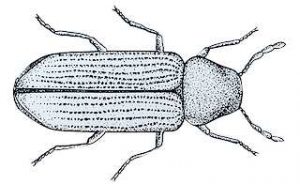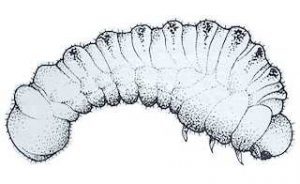Common Furniture Beetle – Anobium punctatum
Next Beetle >>
Habitat

General: Softwoods and European hardwoods.
Solid timber: Sapwood only is affected, unless wood rot is present when it may also be found in heartwood . Very rare in tropical hardwoods. Frequent in older furniture and all constructional timbers, particularly around loft access areas, timbers in contact with solid walls, under stairs, cupboards and other areas affected by damp.
Panel products: Attacks only old birch, beech and oak plywoods with animal based adhesive (blood, fish or casein). Modern plywoods and all other panel products immune, though may be penetrated by emerging adults.
Damage Characteristics

Emergence holes: Circular, 1 – 2 mm diameter (old, extinct damage often accompanied by fine pinholes of parasitic wasps).
Tunnels: Circular, 1 – 2mm diameter. Often extensive, random orientation but mainly in the direction of the grain. Often exposed on the surface of floorboards by general wear.
Bore dust: Cream-coloured, lemon-shaped pellets. Gritty when rubbed between fingers.
Likely misidentifications: Bark borer beetle, pinhole borer beetle, ptilinus beetle, lyctus powderpost beetle, deathwatch beetle, moths, wood-boring weevils.
Remedial Treatments:
Usual: Organic-solvent, emulsion or paste. Damage in very old constructional timbers may often be inactive and if so, will not require treatment.
Other types: Smokes or dichloryos strips.

Appearance
 Larva
Larva
Insect Characteristics and Location:
Adult 3 – 5 mm long, dull brown. Lines of pits on wing covers. Often confused with Stegobium species. Found on and around damaged timber during late March to early August, particularly in warm weather.
Attracted to windows and white surfaces.
Next Beetle >>
